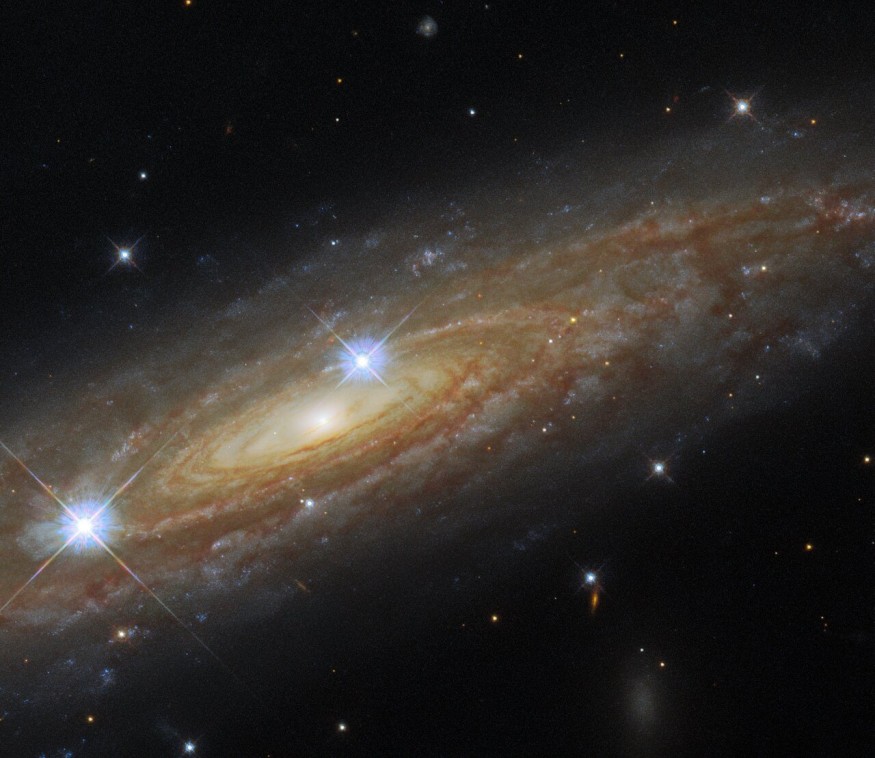NASA/ESA Hubble Space Telescope captured a magnificent image of the spiral galaxy UGC 11537 and another photo of colliding galaxies.
The spiral galaxy is located in the constellation of the Eagle, some 230 million light-years distant. UGC 11537 is a galaxy near the Milky Way's plane.
Meanwhile, the pulling galaxies NGC 5953 and NGC 5954 are merging from millions of light-years distant from Earth.
Hubble Space Telescope Sees a Stunning Side-On Spiral
Experts said the two conspicuous stars in front of UGC 11537 are invaders from within the Milky Way.
"Being so close to the starry band of the Milky Way means that foreground stars from our own galaxy have crept into the image - the two prominent stars in front of UGC 11537 are interlopers from within the Milky Way," ESA said in a statement.
"These bright foreground stars are surrounded by diffraction spikes - imaging artifacts caused by starlight interacting with Hubble's inner structure," the space agency added.
At infrared and visible wavelengths, WFC3 photographed the tightly bound spiral arms swirling around the center of UGC 11537.
According to the astronomers, the photos showed both the brilliant bands of stars and the black clouds of dust threading throughout the galaxy.
This picture was created as part of a series of studies aimed at assisting scientists in weighing supermassive black holes in faraway galaxies.
The Wide Field Camera 3 (WFC3) images in the infrared and optical regions of the spectrum were used to create the new image of the faraway galaxy.

Colliding Galaxy Incoming?
Meanwhile, the Hubble Space Telescope observed two galaxies engaged in a perilous dance that would eventually result in their merger in the far future.
They have probably been dancing for a billion years, and it might take another billion for them to unite.
These are two galaxies having a terrible day, according to Prof Chris Lintott. Lintott is an astronomer at the University of Oxford and presenter of BBC Four's The Sky at Night.
These two spiral galaxies, NGC 5953 and 5954, are colliding.
The material from 5954 is being twisted and warped by the gravitational pull of its companion.
Hubble caught a glimpse of two interacting galaxies, called Arp 91, locked in a dangerous dance more than 100 million light-years from Earth!
— Hubble (@NASAHubble) October 8, 2021
In this #HubbleFriday image, we see how immense gravitational attraction is causing these galaxies to interact: https://t.co/lqmhYfsnzY pic.twitter.com/9ZmMTA4YCF
However, it's improbable that one galaxy is more powerful than the other.
Lintott speculates that it's a reciprocal attraction because they're around the same size. He stated that their gravitational pulls on each other.
Their stars will really remain distinct when they ultimately meet.
"While you won't get a stellar collision, the gas in the galaxy is being distorted and energised so you'll get a spectacular burst of star formation," Lintott said in a BBC's Science Focus report. These galaxies are poised to burst into flames, he added.
Lintott says that after the initial collision, the galaxy will begin to calm down. However, the shape of this new galaxy is still uncertain.
Because they were mentioned in Halton Arp's 1966 Atlas of Peculiar Galaxies, these two galaxies are known as Arp 91.
This shot was taken by a group led by Julianne Dalcanton to photograph a large number of these strange galaxies.
RELATED ARTICLE : NASA Hubble Space Telescope Shares Festive Photo of Snowman Nebula
Check out more news and information on Space in Science Times.
© 2025 ScienceTimes.com All rights reserved. Do not reproduce without permission. The window to the world of Science Times.










